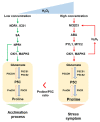H2O2-Responsive Hormonal Status Involves Oxidative Burst Signaling and Proline Metabolism in Rapeseed Leaves
- PMID: 35326216
- PMCID: PMC8944793
- DOI: 10.3390/antiox11030566
H2O2-Responsive Hormonal Status Involves Oxidative Burst Signaling and Proline Metabolism in Rapeseed Leaves
Abstract
Drought alters the level of endogenous reactive oxygen species (ROS) and hormonal status, which are both involved in the regulation of stress responses. To investigate the interplay between ROS and hormones in proline metabolism, rapeseed (Brassica napus L.) plants were exposed to drought or exogenous H2O2 (Exo-H2O2) treatment for 10 days. During the first 5 days, the enhanced H2O2 concentrations in drought treatment were associated with the activation of superoxide dismutase (SOD) and NADPH oxidase, with enhanced ABA and SA levels, while that in Exo-H2O2 treatment was mainly associated with SA-responsive POX. During the latter 5 days, ABA-dependent ROS accumulation was predominant with an upregulated oxidative signal-inducible gene (OXI1) and MAPK6, leading to the activation of ABA synthesis and the signaling genes (NCED3 and MYC2). During the first 5 days, the enhanced levels of P5C and proline were concomitant with SA-dependent NDR1-mediated signaling in both drought and Exo-H2O2 treatments. In the latter 5 days of drought treatment, a distinct enhancement in P5CR and ProDH expression led to higher proline accumulation compared to Exo-H2O2 treatment. These results indicate that SA-mediated P5C synthesis is highly activated under lower endogenous H2O2 levels, and ABA-mediated OXI1-dependent proline accumulation mainly occurs with an increasing ROS level, leading to ProDH activation as a hypersensitive response to ROS and proline overproduction under severe stress.
Keywords: Brassica napus; abscisic acid; drought; hydrogen peroxide; proline; salicylic acid.
Conflict of interest statement
The authors declare no conflict of interest.
Figures






Similar articles
-
Dimethylthiourea Alleviates Drought Stress by Suppressing Hydrogen Peroxide-Dependent Abscisic Acid-Mediated Oxidative Responses in an Antagonistic Interaction with Salicylic Acid in Brassica napus Leaves.Antioxidants (Basel). 2022 Nov 18;11(11):2283. doi: 10.3390/antiox11112283. Antioxidants (Basel). 2022. PMID: 36421468 Free PMC article.
-
Characterization of Glutamate-Mediated Hormonal Regulatory Pathway of the Drought Responses in Relation to Proline Metabolism in Brassica napus L.Plants (Basel). 2020 Apr 16;9(4):512. doi: 10.3390/plants9040512. Plants (Basel). 2020. PMID: 32316109 Free PMC article.
-
Drought Intensity-Responsive Salicylic Acid and Abscisic Acid Crosstalk with the Sugar Signaling and Metabolic Pathway in Brassica napus.Plants (Basel). 2021 Mar 23;10(3):610. doi: 10.3390/plants10030610. Plants (Basel). 2021. PMID: 33806958 Free PMC article.
-
Regulation of levels of proline as an osmolyte in plants under water stress.Plant Cell Physiol. 1997 Oct;38(10):1095-102. doi: 10.1093/oxfordjournals.pcp.a029093. Plant Cell Physiol. 1997. PMID: 9399433 Review.
-
Prolidase-proline dehydrogenase/proline oxidase-collagen biosynthesis axis as a potential interface of apoptosis/autophagy.Biofactors. 2016 Jul 8;42(4):341-8. doi: 10.1002/biof.1283. Epub 2016 Apr 4. Biofactors. 2016. PMID: 27040799 Review.
Cited by
-
Drought-Induced Xylem Sulfate Activates the ABA-Mediated Regulation of Sulfate Assimilation and Glutathione Redox in Brassica napus Leaves.Metabolites. 2022 Nov 29;12(12):1190. doi: 10.3390/metabo12121190. Metabolites. 2022. PMID: 36557228 Free PMC article.
-
Study on the mechanism of exogenous CaCl2 regulating cell growth and development to alleviate salt tolerance of alfalfa (Medicago sativa).Front Plant Sci. 2025 Jul 1;16:1565723. doi: 10.3389/fpls.2025.1565723. eCollection 2025. Front Plant Sci. 2025. PMID: 40666305 Free PMC article.
-
Impact of two Erwinia sp. on the response of diverse Pisum sativum genotypes under salt stress.Physiol Mol Biol Plants. 2024 Feb;30(2):249-267. doi: 10.1007/s12298-024-01419-8. Epub 2024 Feb 25. Physiol Mol Biol Plants. 2024. PMID: 38623163 Free PMC article.
-
Mechanisms of Kale (Brassica oleracea var. acephala) Tolerance to Individual and Combined Stresses of Drought and Elevated Temperature.Int J Mol Sci. 2022 Sep 29;23(19):11494. doi: 10.3390/ijms231911494. Int J Mol Sci. 2022. PMID: 36232818 Free PMC article.
-
Dimethylthiourea Alleviates Drought Stress by Suppressing Hydrogen Peroxide-Dependent Abscisic Acid-Mediated Oxidative Responses in an Antagonistic Interaction with Salicylic Acid in Brassica napus Leaves.Antioxidants (Basel). 2022 Nov 18;11(11):2283. doi: 10.3390/antiox11112283. Antioxidants (Basel). 2022. PMID: 36421468 Free PMC article.
References
-
- La V.H., Lee B.R., Islam M.T., Park S.H., Jung H.I., Bae D.W., Kim T.H. Characterization of salicylic acid-mediated modulation of the drought stress responses: Reactive oxygen species, proline, and redox state in Brassica napus. Environ. Exp. Bot. 2019;157:1–10. doi: 10.1016/j.envexpbot.2018.09.013. - DOI
Grants and funding
LinkOut - more resources
Full Text Sources
Miscellaneous

